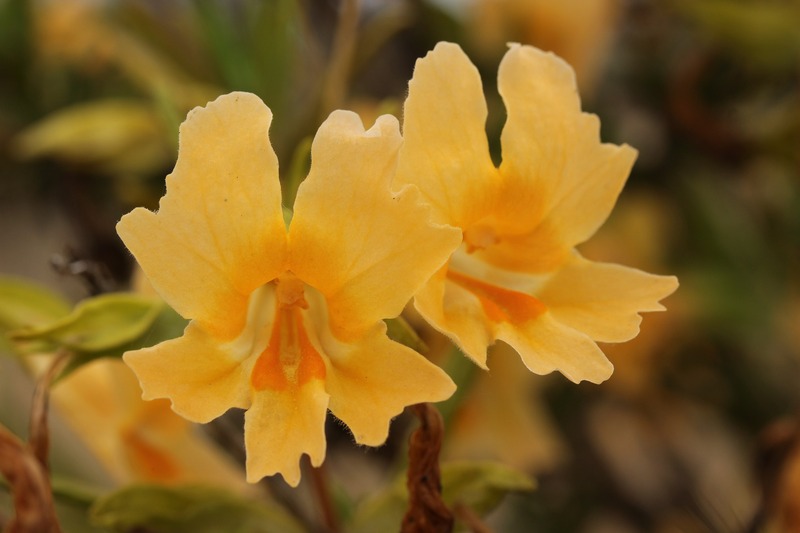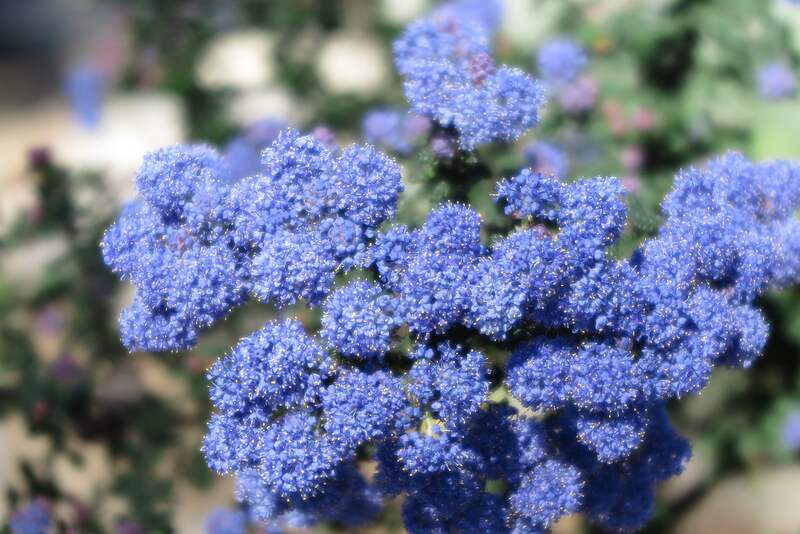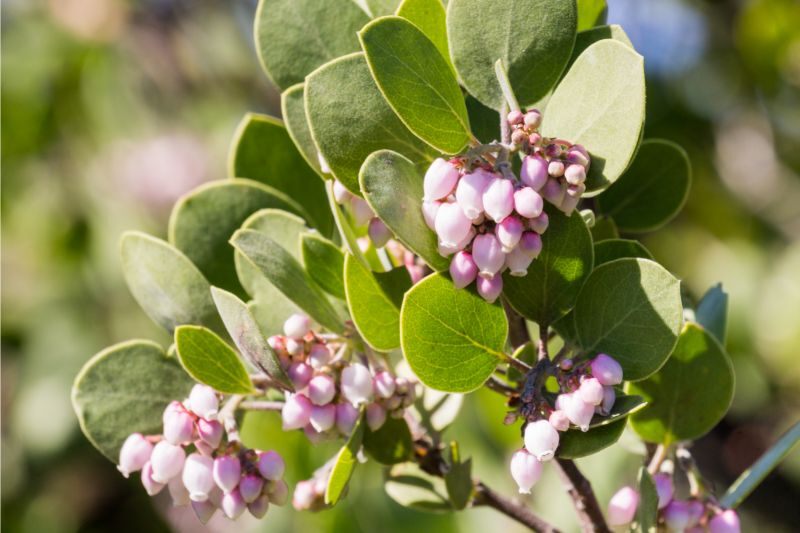
San Diego is a paradise for plant enthusiasts, with its Mediterranean climate that offers mild weather all year round. But with great weather comes great responsibility — the plants in this region must be tough and resilient. That’s why we’ve compiled a list of the 10 best native plants for San Diego.
With San Diego’s relatively dry climate all year round, it’s no surprise that the plants that thrive there must be drought- and sometimes even fire-resistant. Thankfully, this city is home to a diverse array of native plants perfectly adapted to this unique climate, offering many options for those looking to create a stunning and sustainable landscape.
- What is a Native Plant?
- 1. Sage (Salvia)
- 2. San Diego Monkeyflower (Diplacus aurantiacus)
- 3. Succulents
- 4. California Fuchsia (Epilobium canum)
- 5. California Poppy (Eschscholzia californica)
- 6. Desert Mallow (Sphaeralcea ambigua)
- 7. California Lilac (Ceanothus)
- 8. Ian Bush Manzanita (Arctostaphylos ‘Ian Bush’)
- 9. Showy Penstemon (Penstemon spectabilis)
- 10. Narrowleaf Milkweed (Asclepias fascicularis)
- How to Choose Native Plants for Your San Diego Landscape
- FAQ About Native Plants in San Diego
What is a Native Plant?
Native plants naturally occur in a specific region and have evolved to thrive in the local climate and soil conditions. In San Diego, California, native plants are particularly adapted to the area’s warm and mild winters and little to no rainfall, especially from May to September.
These plants have developed various strategies to survive in this arid climate, such as deep roots to access groundwater, thick waxy leaves to reduce water loss, and drought tolerance.
1. Sage (Salvia)

Salvia, commonly known as sage, is a genus of flowering plants native to many parts of the world, including California, where there are 17 different Salvia species. There is a sage plant for every taste, with varieties blooming in every color and varied leaf shapes and textures.
Sage is also known for its ability to thrive in dry areas. As a result, it is an excellent choice for gardeners living in regions with little rainfall, like San Diego, or looking for a low-maintenance plant that doesn’t require a lot of watering.
Popular sage cultivars include Cleveland sage (Salvia Clevelandii), white sage (Salvia apiana), purple sage (Salvia leucophylla), and Pozo blue sage (hybrid Salvia Clevelandii and Salvia leucophylla).
- Plant type: Shrub, subshrub, and herbaceous perennial
- USDA Hardiness Zone: 3-10
- Sun: Full sun, partial shade
- Soil: Prefers loamy or sandy soil, well-drained
- Duration: Perennial
- Fragrance: Varies depending on the species
- Bloom time: Spring, summer, fall
- Water needs: Low
- Mature height: 1-3 feet
- Maintenance: Prune lightly in spring, water once a month during summer
2. San Diego Monkeyflower (Diplacus aurantiacus)

The San Diego monkeyflower, also known as the sticky monkeyflower, is a beautiful and unique plant native to California. One of the most distinctive features of this plant is that when it blooms, the unique pattern on its petals resembles a monkey’s face, making it a whimsical addition to any garden.
Additionally, the San Diego monkeyflower is essential in supporting the ecosystem, providing a vital larval host for the Baltimore and common buckeye butterflies.
- Plant type: Flower
- USDA Hardiness Zone: 3-9
- Sun: Full sun to partial shade
- Soil: Moist soil
- Duration: Perennial
- Fragrance: None
- Bloom time: Winter, spring, and summer
- Water needs: High (Mimulus diplacus species is the most drought-tolerant species)
- Mature height: 1 to 4 feet
- Maintenance: Water regularly until established, prune lightly, and deadhead old flowers.
3. Succulents

Succulents can be a great addition to any San Diego garden. With their unique shapes, textures, and colors, they can create an enchanting oasis in the warm and dry climate of San Diego. They can store water within their plump leaves and stems, allowing them to flourish with minimal water and care.
Aloe vera, agave, and various cacti are just a few examples of the lovely succulents you can incorporate into your outdoor space. And as if their beauty and hardiness weren’t enough, aloe vera offers an additional benefit – its gel can be used for soothing and healing the skin.
- Plant type: Succulent
- USDA Hardiness Zone: 3 – 11, depending on the species
- Sun: Full sun (though some prefer afternoon shade)
- Soil: Well-drained
- Duration: Most are perennials
- Fragrance: None
- Bloom time: Varies depending on the species
- Water needs: Low
- Mature height: Varies depending on the species
- Potential hazards: Aloe vera, euphorbias, kalanchoes, and jade plants have low levels of toxicity (may vary by cultivar), so keep away from kids and pets.
- Maintenance: Make sure they get enough light
4. California Fuchsia (Epilobium canum)

The California fuchsia is a low-growing perennial shrub that can add a touch of color to your garden with its dazzling scarlet to orange-red flowers. This plant thrives in sunny locations and well-drained soil, making it perfect for your San Diego home.
During the dry summer months, the California fuchsia requires light watering to maintain healthy growth. However, one of the most endearing aspects of the California fuchsia is its ability to attract hummingbirds. This plant is an excellent choice if you want to create a haven for these birds.
- Plant type: Shrub
- USDA Hardiness Zone: 8 – 11
- Sun: Full sun and partial shade
- Soil: Clay and sand
- Duration: Perennial
- Fragrance: None
- Bloom time: Mid-summer into fall
- Water needs: Light watering once a month during summer
- Mature height: 1 to 3 feet
- Maintenance: Pruning in fall or early winter
5. California Poppy (Eschscholzia californica)

The California poppy (Eschscholzia californica) is honored as California’s state flower. With its cheerful yellow hue, this charming blossom brings a sense of warmth and happiness wherever it grows.
One of the best aspects of the California poppy is that it grows quickly, is drought-tolerant, and has a slight earthy scent. In addition, while the California poppy is a perennial, it is best grown as an annual, allowing you to enjoy a fresh burst of color year after year.
- Plant type: Flower
- USDA Hardiness Zone: 8 – 10
- Sun: Full sun
- Soil: Infertile, well-drained, sandy soils
- Duration: Annual or perennial
- Fragrance: Earthy
- Bloom time: February to September
- Water needs: Low
- Mature height: 0.15 to 2 feet
- Maintenance: Deadheading is good for additional flowering, but leave some so the flower self-seeds.
6. Desert Mallow (Sphaeralcea ambigua)

The desert mallow is a low-maintenance plant that thrives in heat and drought conditions, making it an ideal choice for homeowners in San Diego’s dry climate. Additionally, the desert mallow’s aversion to wet winters further solidifies its suitability for Southern California gardens, where it will flourish with minimal care.
This plant is an alluring and resilient species known for its vibrant orange-red flowers that capture the attention of both honeybees and butterflies. These pollinators are drawn to the rich pollen and nectar these flowers provide, which in turn aids in the plant’s reproduction (it self-seeds!).
- Plant type: Shrub
- USDA Hardiness Zone: 6-9
- Sun: Full sun
- Soil: Dry, rocky, or sandy soils
- Duration: Perennial
- Fragrance: None
- Bloom time: Spring, summer, and fall
- Water needs: Low
- Mature height: 3 to 4 feet
- Potential hazards: The small hairs on the leaf can be an eye irritant.
- Maintenance: Prune after blooming
7. California Lilac (Ceanothus)

The California lilac, or Ceanothus, is a remarkable and versatile plant known for its beautiful lilac flowers, as the name suggests. California is home to over 172 native species of Ceanothus, including “Frosty Blue,” “Dark Star,” and “Concha.” With so many different species to choose from, it’s easy to find a variety you’ll love.
These stunning shrubs are a feast for the eyes and boast several practical qualities: they are drought and salt-tolerant, making them ideal for San Diego County’s coastal areas.
Furthermore, the California lilac’s fast-growing nature ensures it quickly establishes itself in the landscape, providing a vibrant and eye-catching display.
- Plant type: Small shrub to large, tree-size shrub
- USDA Hardiness Zone: 8-10
- Sun: Full sun or partial shade
- Soil: Well-drained
- Duration: Perennial
- Fragrance: Sweet
- Bloom time: Depends on the cultivar
- Water needs: Low
- Mature height: Varies widely depending on the landscape and cultivar: from small, mounding shrubs (maritime ceanothus) of a few feet tall to large shrubs (blueblossom ceanothus) around 30 feet tall
- Maintenance: Lightly prune after it finishes flowering.
8. Ian Bush Manzanita (Arctostaphylos ‘Ian Bush’)

The Ian Bush manzanita is a distinctive medium-sized variety of manzanita that can become the star of your winter garden, bringing color to an otherwise dormant landscape. It has a smooth, red bark and delicate, light pink flowers contrasting with the more subdued hues typical of winter foliage.
This manzanita’s natural drought tolerance and preference for well-draining soils align perfectly with San Diego’s typical weather patterns, allowing it to thrive with minimal intervention.
- Plant type: Shrub
- USDA Hardiness Zone: 7-10
- Sun: Full sun and partial shade
- Soil: Adaptable but prefers well-drained soil
- Duration: Perennial
- Fragrance: None
- Bloom time: Fall and winter
- Water needs: Low to moderate
- Mature height: 4 to 6 feet
- Maintenance: Prune to remove dead branches
9. Showy Penstemon (Penstemon spectabilis)

Showy penstemon, or Penstemon spectabilis, is a beautiful and versatile perennial that boasts thin leaves and clusters of stunning purple-blue flowers. These fast-growing plants are easy to cultivate in climates like San Diego. Their natural drought tolerance and preference for well-draining soils allow them to flourish with minimal care.
The vibrant blossoms of showy penstemon provide a dazzling visual display and serve as a magnet for hummingbirds, butterflies, and other beneficial pollinators.
- Plant type: Subshrub, herbaceous perennial
- USDA Hardiness Zone: 8-11
- Sun: Full sun
- Soil: Well-drained soils
- Duration: Perennial
- Fragrance: None
- Bloom time: Winter, spring
- Water needs: Low
- Mature height: 2 to 4 feet
- Potential hazards: This plant accumulates selenium, so it’s best to keep it away from pets.
- Maintenance: Water once a month if planted in a well-drained area, and don’t water if planted in loamy or clay soil.
10. Narrowleaf Milkweed (Asclepias fascicularis)

The narrowleaf milkweed is a fascinating plant characterized by its long pointed leaves, which elegantly whorl around the stem. They also have clusters of delicate lavender-white flowers and milkweed pods. Once matured, these pods release a bounty of seeds, ensuring propagation.
In California, the narrowleaf milkweed plays a vital ecological role as a larval host for the beautiful Monarch butterflies. On the downside, they also attract a lot of aphids, which may become a problem.
- Plant type: Subshrub, herbaceous perennial
- USDA Hardiness Zone: 6-10
- Sun: Full sun
- Soil: Adaptable to many types, including sandy and clay
- Duration: Perennial
- Fragrance: Vanilla-like scent
- Bloom time: Late summer
- Water needs: Moderate
- Mature height: 1.5 to 4 feet
- Potential hazards: Contains glycoside, which is toxic to pets and humans
- Maintenance: Do not use any pesticide, as it can kill Monarch caterpillars; water once a week
How to Choose Native Plants for Your San Diego Landscape
When choosing new native plants for your California garden, consider the following factors to ensure a thriving and visually appealing landscape:
- Select plants compatible with San Diego’s USDA Hardiness Zone (8 – 10) to ensure they thrive in the local climate.
- Evaluate soil preferences, as some plants thrive in well-drained sandy soil, while others require clay soil.
- Use a variety of flowering plants that bloom at different times throughout the year, providing a continuous display of color to your landscape.
- Assess each plant’s water requirements, ensuring they are heat and drought-tolerant plants to withstand San Diego’s arid conditions.
- Consider your personal needs — if you prefer a low-maintenance garden, opt for hardy, easy-to-care-for plants that require minimal attention.
FAQ About Native Plants in San Diego
San Diego, California, is situated within USDA Hardiness zones 8, 9, and 10. This indicates that plants in the area should be capable of enduring minimum extreme temperatures ranging from 10 to 15 degrees Fahrenheit in winter, while in the hotter regions, they should withstand temperatures between 30 to 35 degrees Fahrenheit minimum.
You can ensure their survival and growth in San Diego’s unique climate conditions by selecting plants suited to these hardiness zones.
In addition to the wildflowers previously mentioned, the following wildflowers are native to San Diego:
● Snapdragon (Antirrhinum)
● Wooly Blue Curls (Trichostema lanatum)
● Margarita BOP (Penstemon heterophyllus)
● Yarrow (Achillea millefolium)
● Pigeon Point (Baccharis pilularis)
The best plants in San Diego for attracting butterflies typically feature nectar-rich flowers that provide a valuable food source for these delightful pollinators. Some popular options include:
● Desert mallow
● Showy penstemon
● Tall verbena
● Blue salvias
Additionally, it is essential to incorporate host plants, such as the narrowleaf milkweed and the San Diego monkeyflower, which offer leaves for feeding hungry caterpillars.
When to Bring in The Professionals
Incorporating native species into your San Diego garden can provide numerous benefits, such as enhancing local biodiversity, conserving water, and adding visual appeal. To make your landscape a true reflection of your personality, consider enlisting the expertise of a professional landscaper in San Diego.
Disclaimer: Although we’ve done our best to make readers aware of potential hazards, the hazards listed are by no means comprehensive and are for educational use only. Research each plant you buy for safety, especially if you have little feet or paws running around your yard.
Main Image Credit: Rawpixel